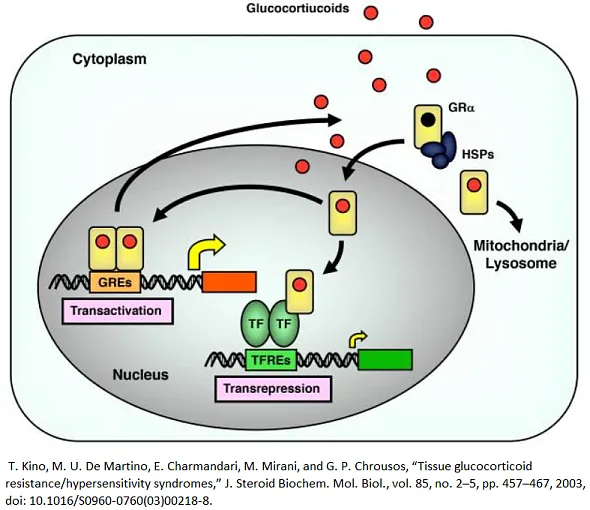Glucocorticoid receptors Library
ChemDiv’s library of small molecules specifically targeting glucocorticoid receptors contains 5,000 compounds
The Glucocorticoid Receptor (GR), a founding member of the nuclear receptor superfamily, is a ubiquitously expressed, ligand-regulated transcriptional regulatory factor (TRF) in all vertebrates. GR has evolved to bind specific small, lipophilic signaling molecules. Upon binding to the specific ligand i.e., glucocorticoid, this receptor shuttles between the cytoplasm and the nucleus, where it modulates the transcription rates of glucocorticoid-responsive genes, both positively and negatively. Expressed in nearly all vertebrate cells, GR directly upregulates and downregulates thousands of genes specific to each type of cells, governing various aspects of development, metabolism, stress response, inflammation, and other critical tissue and organismal processes. Hence, the control of gene transcription by GR is critical for development, physiology, and homeostasis, with aberrant transcription regulation often leading to disease processes [1].
Dysregulation of the glucocorticoid hormone's negative feedback system (for example, cortisol) and its overexpression in humans can lead to several disease states, including Cushing's syndrome, psychotic depression, diabetes, obesity, Alzheimer's disease, neuropathic pain, drug abuse, and glaucoma. In recent years, there has been active research into discovering selective modulators of the GR [2].
GRs play a significant role in drug discovery due to their widespread influence on various physiological processes, including metabolism, immune response, stress response, and inflammation. As ligand-activated transcription factors, they regulate the expression of numerous genes across different cell types, making them pivotal targets for therapeutic interventions. The modulation of GR activity can lead to profound effects on the body's homeostasis, which is crucial in treating a range of disorders.
The main types of drugs affecting GRs can be categorized as agonists, antagonists, and selective glucocorticoid receptor modulators (SGRMs):
- Agonists: These drugs, including synthetic glucocorticoids like prednisone and dexamethasone, mimic the action of natural glucocorticoids (e.g., cortisol). They are extensively used for their anti-inflammatory and immunosuppressive properties, making them effective in treating conditions like asthma, allergies, autoimmune diseases, and in preventing organ transplant rejection.
- Antagonists: These compounds, such as mifepristone, block the action of glucocorticoids. They are used in conditions where glucocorticoid suppression is desired, such as in Cushing's syndrome, where there is an overproduction of cortisol.
- Selective Glucocorticoid Receptor Modulators (SGRMs): These newer compounds offer a more targeted approach, designed to provide the beneficial anti-inflammatory effects of glucocorticoids while minimizing side effects. They selectively modulate GR activity, potentially offering improved therapies for chronic inflammatory diseases, metabolic disorders, and perhaps even specific cancers.
The ability to target GRs with these various drug types offers a powerful approach in managing a diverse array of health conditions, making GRs a focal point in both pharmacological research and therapeutic application.
The compound library of glucocorticoid receptor (GR) ligands offers substantial benefits for drug discovery, particularly in the realm of inflammatory, autoimmune, metabolic, and stress-related disorders.
- Firstly, this library provides a diverse array of both agonists and antagonists, allowing researchers to explore and identify compounds that can modulate the GR pathway in various ways. This versatility is crucial for developing treatments that can either mimic or inhibit the natural effects of glucocorticoids, depending on therapeutic need.
- Secondly, the library enables the screening of SGRMs, which hold the potential to offer the anti-inflammatory benefits of traditional glucocorticoids while minimizing adverse effects. This is particularly important for chronic conditions where long-term glucocorticoid therapy is limited by its side effects.
- Thirdly, having a range of GR ligands facilitates a better understanding of the receptor's role in different physiological and pathological processes, which can lead to the discovery of novel therapeutic targets and mechanisms.
- Lastly, the library aids in speeding up the drug development process by providing a wide spectrum of chemically characterized and biologically tested compounds, thereby reducing the time and resources required for the initial stages of drug discovery.
References
[1] E. R. Weikum, M. T. Knuesel, E. A. Ortlund, and K. R. Yamamoto, “Glucocorticoid receptor control of transcription: Precision and plasticity via allostery,” Nat. Rev. Mol. Cell Biol., vol. 18, no. 3, pp. 159–174, 2017, doi: 10.1038/nrm.2016.152.
[2] R. Clark, “Glucocorticoid Receptor Antagonists,” Curr. Top. Med. Chem., vol. 8, no. 9, pp. 813–838, 2008, doi: 10.2174/156802608784535011.
